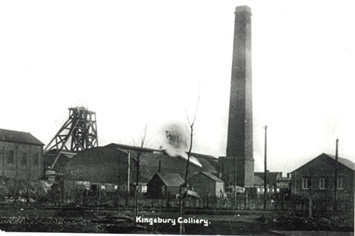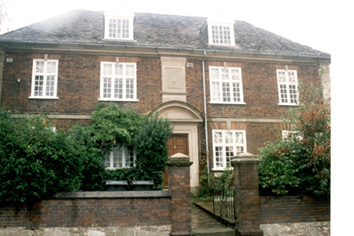|
The parish of
Kingsbury was once much larger than it is now and included the
hamlets of Hurley, Whateley, Slateley, Dosthill, Cliff,
Bodymoor Heath, Coton, Whitacre Heath and Plumpton. Many of
these settlements still exist while others have been reduced
to single farmhouses or have disappeared altogether. Kingsbury
was the most important settlement of the parish having the ‘mother’ church of St Peter & St. Paul.
There is evidence
of both Prehistoric and Romano-British habitation in the area
and after the Romans left Britain in AD.410, Mercia emerged as
the largest and most important of the Saxon kingdoms. By the
time Offa became its king in AD.757, Tamworth had become the
favoured capital and residence. The Saxon name for Kingsbury
is ‘CHINESBURIE’
meaning ‘a royal, fortified site’. Situated on a bluff
above the river with a panoramic view across the Tame valley,
it was a strategically important place to build a ‘burh’
or fortification. The surrounding countryside provided a rich
hunting ground with its proximity to the great Forest of Arden
and the ‘burh’ may well have been a royal retreat. In
AD.851 King Bertwulf, fearing the threat of a Danish invasion,
called all his nobles together in a ‘Great Council’ at
Kingsbury to make plans that proved to be useless when
Tamworth was sacked in AD.874.
By the reign of
Edward the Confessor, Kingsbury was held by Earl Leofric of
Mercia and his wife, the Countess Godiva but they were
deprived of it by William I who gave it to Turchill de Arden
after the Norman Conquest. The Domesday entry for the village
describes it as an estate of about 700 acres worked by 33
villeins who held land in return for services rendered to the
Lord of the manor. There was an area of woodland to the
north-east, two priests and a mill valued at 9s 4d making it
an estate of average wealth. Turchill de Arden’s wife was
Godiva’s granddaughter Leverunia and from them the manor of
Kingsbury passed by marriage into the Bracebridge family.
From the 13th
to the mid 16th centuries, Kingsbury’s fortunes
laid in the hands of this soldiering family from Lincolnshire
several of whom fought for their country at Crecy and
Agincourt. Many were knights, the last being Sir Ralph de
Bracebridge in 1403, and they built a chapel onto the church
in which now lies the remains of two desecrated effigies. The
Bracebridges built and lived in Kingsbury Hall although little
of their building now survives as additions and alterations
have been made over the centuries. The last Bracebridge to
hold the manor was Thomas the Younger in 1585 when he duped
Sir Francis Willoughby of Middleton Hall into buying it in
order to extricate himself from debt. Poor Sir Francis was an
unlucky man having the misfortune to have married a wife who
may well have poisoned him!

The manor
eventually passed into the Peel family from Drayton Manor, and
four successive Sir Robert Peels owned land in the parish that
has always been essentially a farming community. Industry
started to appear towards the end of the 19th century with the opening of Cliff Brickworks but it was the
development of the Warwickshire coalfield that brought the
greatest change to the village.
Kingsbury Colliery
was opened in 1897 and almost overnight fortunes changed as
farming gradually gave way to the extraction of coal for use
in Birmingham and at Coleshill’s Lurghi Plant. After the
colliery shut in 1968, additional farming land was lost to the
more lucrative gravel extraction at Bodymoor Heath and to the
construction of the Oil Terminal on the Trinity Road.
Kingsbury Water Park grew out of the old, gravel workings in
1975 and has become a haven for bird watchers and walkers
alike.

Of all the houses
in the village, the oldest and one of the most interesting is
the School House in Church Lane dating from 1684 and given by
Sir Thomas Coton for the provision of a rudimentary education
for the local poor children.

Kingsbury is now a
large, semi-rural village that with construction of the M42
motorway, has become very much a ‘dormer’ community for
the surrounding towns and cities. |



